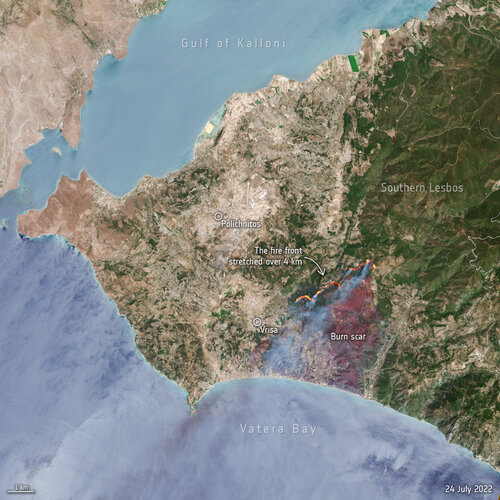China successfully launches lab to Tiangong space station
Tuesday, 26 July 2022 11:15 China has successfully launched a laboratory to its space station orbiting Earth, the Asian nation's space agency said.
The 23-ton Wentian lab module was launched aboard the Long March 5B rocket from China's Wenchang Space Launch Site in Hainan Province at 2:22 p.m. Sunday and docked to the core module of the Tiangong Space Station early Monday, the China Manned Space Agency said.
China has successfully launched a laboratory to its space station orbiting Earth, the Asian nation's space agency said.
The 23-ton Wentian lab module was launched aboard the Long March 5B rocket from China's Wenchang Space Launch Site in Hainan Province at 2:22 p.m. Sunday and docked to the core module of the Tiangong Space Station early Monday, the China Manned Space Agency said. China releases images of Martian satellite
Tuesday, 26 July 2022 11:15 China's Tianwen-1 probe beamed back high-resolution images of Mars' natural satellite Phobos on Saturday, marking the second anniversary of the launch.
Phobos and Deimos are two natural satellites of the red planet. Phobos is the larger one with an irregular shape with no atmosphere and the closest satellite to the main star in the solar system.
The Tianwen-1 operation team seized th
China's Tianwen-1 probe beamed back high-resolution images of Mars' natural satellite Phobos on Saturday, marking the second anniversary of the launch.
Phobos and Deimos are two natural satellites of the red planet. Phobos is the larger one with an irregular shape with no atmosphere and the closest satellite to the main star in the solar system.
The Tianwen-1 operation team seized th HawkEye 360 opens satellite manufacturing facility in Virginia
Tuesday, 26 July 2022 06:37
HawkEye 360 has opened a new manufacturing facility near its northern Virginia headquarters that will help the company accelerate the deployment of its constellation of radio-frequency (RF) monitoring satellites.
The post HawkEye 360 opens satellite manufacturing facility in Virginia appeared first on SpaceNews.
DoD signaling demand for satellite support services in geostationary orbit
Monday, 25 July 2022 18:56
The Defense Innovation Unit is funding space projects that the agency hopes will spur commercial investments in satellite refueling technologies and support services for geostationary satellites.
The post DoD signaling demand for satellite support services in geostationary orbit appeared first on SpaceNews.
Explosive volcanic eruption produced rare mineral on Mars
Monday, 25 July 2022 14:00
Planetary scientists from Rice University, NASA's Johnson Space Center and the California Institute of Technology have an answer to a mystery that's puzzled the Mars research community since NASA's Curiosity rover discovered a mineral called tridymite in Gale Crater in 2016.
Tridymite is a high-temperature, low-pressure form of quartz that is extremely rare on Earth, and it wasn't immediately clear how a concentrated chunk of it ended up in the crater. Gale Crater was chosen as Curiosity's landing site due to the likelihood that it once held liquid water, and Curiosity found evidence that confirmed Gale Crater was a lake as recently as 1 billion years ago.
Greece battles wildfires on Lesbos island
Monday, 25 July 2022 13:36 Image:
Hundreds of residents and tourists have been evacuated from the Greek island of Lesbos after a wildfire broke out on the morning of 23 July. This image, captured by Sentinel-2, shows the active fire front which stretches for more than four km.
Image:
Hundreds of residents and tourists have been evacuated from the Greek island of Lesbos after a wildfire broke out on the morning of 23 July. This image, captured by Sentinel-2, shows the active fire front which stretches for more than four km. Eutelsat and OneWeb discussing multi-orbit merger plan
Monday, 25 July 2022 12:46
Eutelsat said July 25 it is in talks to merge with OneWeb to create a global multi-orbit satellite broadband operator.
The post Eutelsat and OneWeb discussing multi-orbit merger plan appeared first on SpaceNews.
Eutelsat and OneWeb agree multi-orbit merger plan
Monday, 25 July 2022 12:46
Eutelsat and OneWeb said July 26 they have agreed a plan to merge their businesses to create a global multi-orbit satellite broadband operator.
The post Eutelsat and OneWeb agree multi-orbit merger plan appeared first on SpaceNews.
NASA wants your help designing a starshade to observe exoplanets
Monday, 25 July 2022 12:21
The field of exoplanet study has come a long way in recent decades. To date, 5,063 exoplanets have been confirmed in 3,794 systems beyond our own, with another 8,819 candidates awaiting confirmation. In the coming years, tens of thousands of more planets are expected to be found, thanks to next-generation observatories. The ultimate goal in this search is to find planets that are "Earth-like," meaning they have a good chance of supporting life. This is no easy task, as rocky planets located within their parent star's habitable zones (HZs) tend to orbit closely, making them harder to see.
To make this process easier, NASA is designing a hybrid observatory consisting of a "Starshade" that will block out a star's light so that a ground-based telescope can directly image planets orbiting it.
Chinese astronauts set up new lab on space station
Monday, 25 July 2022 11:11 Astronauts entered the new lab module of China's space station for the first time Monday, in a major step towards completing the orbital outpost by the end of the year.
The station is one of the crown jewels of Beijing's ambitious space programme, which has landed robotic rovers on Mars and the Moon, and made China only the third nation to put humans in orbit.
Once completed, Tiangong --
Astronauts entered the new lab module of China's space station for the first time Monday, in a major step towards completing the orbital outpost by the end of the year.
The station is one of the crown jewels of Beijing's ambitious space programme, which has landed robotic rovers on Mars and the Moon, and made China only the third nation to put humans in orbit.
Once completed, Tiangong -- Marine Management Organisation opens consultation on Virgin Orbit launch site
Monday, 25 July 2022 11:11 The Marine Management Organisation (MMO) is consulting on the determination of a marine licence application from Virgin Orbit, proposing to launch a satellite from Spaceport Cornwall in Newquay.
Virgin Orbit proposes to conduct a maximum of one launch in 2022 and two launches per year over the next 8 years (January 2023 - December 2030).
As the material to be deposited will be loaded
The Marine Management Organisation (MMO) is consulting on the determination of a marine licence application from Virgin Orbit, proposing to launch a satellite from Spaceport Cornwall in Newquay.
Virgin Orbit proposes to conduct a maximum of one launch in 2022 and two launches per year over the next 8 years (January 2023 - December 2030).
As the material to be deposited will be loaded Third Test Flight for DARPA's HAWC Yields New Performance Data
Monday, 25 July 2022 11:11 DARPA's Hypersonic Air-breathing Weapon Concept (HAWC), a missile program conducted in partnership with the U.S. Air Force, completed another successful free flight in early July. This is the second demonstration vehicle built by Raytheon Technologies to meet test objectives. The first Raytheon flight was in September 2021. It was followed by success with a different contractor's vehicle configu
DARPA's Hypersonic Air-breathing Weapon Concept (HAWC), a missile program conducted in partnership with the U.S. Air Force, completed another successful free flight in early July. This is the second demonstration vehicle built by Raytheon Technologies to meet test objectives. The first Raytheon flight was in September 2021. It was followed by success with a different contractor's vehicle configu SpaceX launches another 53 Starlink satellites in sixth launch of month
Monday, 25 July 2022 11:11 SpaceX sent another 53 Starlink satellites into orbit Sunday with its 33rd launch of the year, just days after the company broke its annual record set in 2021.
That satellites were sent into low-Earth orbit from Launch Complex 39A at Kennedy Space Center in Florida at 9:38 a.m. EDT, the company said in a statement.
The Falcon 9 rocket's first stage booster landed on the A Shortfa
SpaceX sent another 53 Starlink satellites into orbit Sunday with its 33rd launch of the year, just days after the company broke its annual record set in 2021.
That satellites were sent into low-Earth orbit from Launch Complex 39A at Kennedy Space Center in Florida at 9:38 a.m. EDT, the company said in a statement.
The Falcon 9 rocket's first stage booster landed on the A Shortfa Some asteroids aged early by Sun
Monday, 25 July 2022 11:11 Scientists from NASA's OSIRIS-REx mission recently learned that surface regeneration happens a lot quicker on asteroids than on Earth. By analyzing rock fractures on asteroid Bennu from high-resolution images taken by the OSIRIS-REx spacecraft, the team discovered that the Sun's heat fractures rocks on Bennu in just 10,000 to 100,000 years. This information will help scientists estimate how long
Scientists from NASA's OSIRIS-REx mission recently learned that surface regeneration happens a lot quicker on asteroids than on Earth. By analyzing rock fractures on asteroid Bennu from high-resolution images taken by the OSIRIS-REx spacecraft, the team discovered that the Sun's heat fractures rocks on Bennu in just 10,000 to 100,000 years. This information will help scientists estimate how long How do collisions of rocks with planets help the planets evolve?
Monday, 25 July 2022 11:11 Planetary scientist Katarina Miljkovic is available to discuss the nature of planets in Melbourne this week. It's part of a national tour of public and school talks promoting opportunities for women in physics.
The planets in our solar system are vastly different although they all formed from the same cloud of gas and dust around a star - our sun. Why is this?
Associate Professor Kat
Planetary scientist Katarina Miljkovic is available to discuss the nature of planets in Melbourne this week. It's part of a national tour of public and school talks promoting opportunities for women in physics.
The planets in our solar system are vastly different although they all formed from the same cloud of gas and dust around a star - our sun. Why is this?
Associate Professor Kat 
